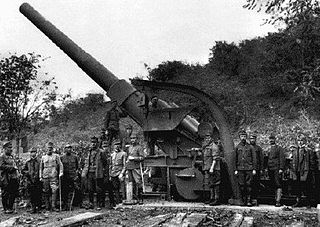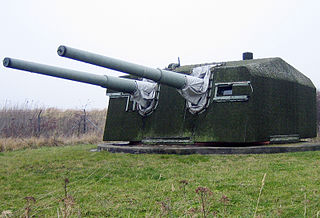
The Sd.Kfz. 250 was a light armoured half-track, very similar in appearance to the larger Hanomag-designed Sd.Kfz. 251, and built by the DEMAG firm, for use by Nazi Germany in World War II. Most variants were open-topped and had a single access door in the rear.

The Nebelwerfer was a World War II German series of weapons. They were initially developed by and assigned to the Army's Nebeltruppen. Initially, two different mortars were fielded before they were replaced by a variety of rocket launchers ranging in size from 15 to 32 centimetres. The thin walls of the rockets had the great advantage of allowing much larger quantities of gases, fluids or high explosives to be delivered than artillery or even mortar shells of the same weight. With the exception of the Balkans Campaign, Nebelwerfer were used in every campaign of the German Army during World War II. A version of the 21 cm (8.3 in) calibre system was adapted for air-to-air use against Allied bombers.

The 10 cm Kanone 17 was a field gun used by Germany in World War I and World War II.

The 10 cm Nebelwerfer 35 was a heavy mortar used by Germany during World War II. Much like the American M2 4.2 inch mortar it was intended to deliver chemical munitions, such as gas and smoke shells. Unlike the American weapon it appears to have had an ordinary high-explosive shell from the beginning. It was of conventional design, and was virtually a scaled-up 8 cm GrW 34. It broke down into the standard three loads for transport. The tube weighed 31.7 kg (70 lb), the baseplate 36.3 kg (80 lb) and the bipod 32.2 kg (71 lb). Each could be man-packed for some distance, but small handcarts were issued for longer distances. Each mortar squad consisted of a squad leader, three gunners and three ammunition bearers.

The 8 cm kanon vz. 30 was a Czech field gun used in World War II. Guns captured after the German invasion of Czechoslovakia in March 1939 were taken into Wehrmacht service as the 8 cm FK 30(t). It was used by a variety of German units during World War II, including I./SS-Artillerie-Abteilung 3 between 1939 and 1940.

The 10 cm houfnice vz. 30 was a Czechoslovak howitzer used in the Second World War. The 158 weapons captured after the German invasion of Czechoslovakia in March 1939 were taken into Wehrmacht service as the 10 cm leFH 30(t). It was used by a variety of German units during World War II, including II. and III./SS-Artillerie-Abteilung 3 between 1939 and 1940 and SS-Artillerie-Abteilung 51 during 1941. 30 served with the Slovak Army.
The 21 cm Kanone 38 was a heavy gun used by Germany in World War II. Its development began in 1938 after Krupp's success with the 21 cm Mrs 18, but it was not fielded until 1941. It likely equipped Artillerie-Abteilungen 767 and 768, which were the only Heer battalions to field 21 cm guns during the war. Some guns may have served on coastal defence duties.

The 24 cm houfnice vz.39 was a Czechoslovak-designed siege howitzer used in the Second World War. It was kept in production after the German occupation of Czechoslovakia in March 1939 and eighteen were delivered to the Germans. It was only used by the Army's Artillery Regiment 814 and entered service shortly before the Battle of France in 1940. The regiment participated in Operation Barbarossa and in the Sieges of Sevastopol and Leningrad.
The 15 cm SchiffsKanone C/28 in Mörserlafette was a German heavy gun used in the Second World War.

The 24-cm-Kanone 3 was a German heavy siege gun used in the Second World War by the first battalion of Artillerie-Regiment 84. Four were in service when Germany invaded Poland, assigned to the first two batteries of I./AR 84, and in the Battle of France. By Operation Barbarossa all three batteries were equipped with two guns apiece. This situation did not change for the next two years.

The 24 cm Kanone M. 16 was a super-heavy siege gun used by Austria-Hungary during World War I and by Nazi Germany during World War II. Only two were finished during World War I, but the other six were completed in the early twenties and served with the Czechoslovak Army until they were bought by the Germans after the German occupation of Czechoslovakia in 1938. During World War I, one gun served on the Western Front and the other on the Italian Front. During World War II, they saw action in the Battle of France, Operation Barbarossa and the siege of Leningrad.
Lehr-Brigade (mot.) 900 was formed 17 June 1941 by the German Army from school units in preparation for Operation Barbarossa. As such it was considered an elite as many of its personnel were instructors in tactics from various branch schools. It fought in most of the battles in the central sector of the Eastern Front during Barbarossa, notably the Battles of Minsk, Smolensk, Operation Typhoon and the Battle of Moscow before its remnants were withdrawn in April–May 1942.

The 20.3 cm Kanone was a German railroad gun used on coast-defense duties in Occupied France and Belgium during World War II. Eight guns were transferred from the Navy's stocks after having become redundant with the loss and sale of several Admiral Hipper-class heavy cruisers and were delivered in 1941 and 1942.

The 21 cm Nebelwerfer 42 was a German multiple rocket launcher used in the Second World War. It served with units of the Nebeltruppen, the German equivalent of the American Chemical Corps. Just as the Chemical Corps had responsibility for poison gas and smoke weapons that were used instead to deliver high-explosives during the war so did the Nebeltruppen. The name "Nebelwerfer" is best translated as "Smoke Mortar". It saw service from 1942–45 in all theaters except Norway. It was adapted for aerial combat by the Luftwaffe in 1943.

The 28/32 cm Nebelwerfer 41 was a German multiple rocket launcher used in the Second World War. It served with units of the so-called Nebeltruppen, the German equivalent of the U.S. Army's Chemical Corps. The Nebeltruppen had responsibility for poison gas and smoke weapons that were used instead to deliver high-explosives during the war. The name "Nebelwerfer" is best translated as "Smoke Mortar". It saw service from 1941–45 in all theaters except Norway and the Balkans.

The 30 cm Nebelwerfer 42 was a German multiple rocket launcher used in the Second World War. It served with units of the Nebeltruppen, the German equivalent of the U.S. Army's Chemical Corps. Just as the Chemical Corps had responsibility for poison gas and smoke weapons that were used instead to deliver high-explosives during the war so did the Nebeltruppen. The name "Nebelwerfer" is best translated as "Smoke Mortar". It saw service from 1943 to 1945 in all theaters except Norway and North Africa.

The 30 cm Raketenwerfer 56 was a German multiple rocket launcher used in the Second World War. It served with units of the Nebeltruppen, the German equivalent of the U.S. Army's Chemical Corps. Just as the Chemical Corps had responsibility for poison gas and smoke weapons that were used instead to deliver high-explosives during the war so did the Nebeltruppen. The name "Nebelwerfer" is best translated as "Smoke Mortar". 694 saw service from 1944–45 in all theaters except Norway.

The 35.5 cm Haubitze M1 was a German siege howitzer. It was developed by Rheinmetall before World War II to meet the German Army's request for a super-heavy howitzer. Eight were produced between 1939 and 1944. It saw service in the Battle of France and spent the rest of the war on the Eastern Front, saw action in Operation Barbarossa, the siege of Sevastopol, the siege of Leningrad and helped to put down the Warsaw Uprising in 1944.

The 21 cm Kanone 39 was a Czech-designed heavy gun used by the Germans in the Second World War. Two were built before the Germans occupied Czechoslovakia in March 1939 and seized the rest of the guns and kept it in production for their own use, eventually building a total of 60 guns for themselves. They saw action in Operation Barbarossa, the siege of Odessa, siege of Leningrad and the siege of Sevastopol and were used on coast defence duties.

The 15 cm SK C/28 was a German medium-caliber naval gun used during the Second World War. It served as the secondary armament for the Bismarck class and Scharnhorst-class battleships, Deutschland-class cruisers and the Graf Zeppelin-class aircraft carriers. A number of surplus weapons were used as coast-defense guns and eight were adapted to use Army carriages and used as heavy field guns as the 15 cm Schiffskanone C/28 in Mörserlafette

















